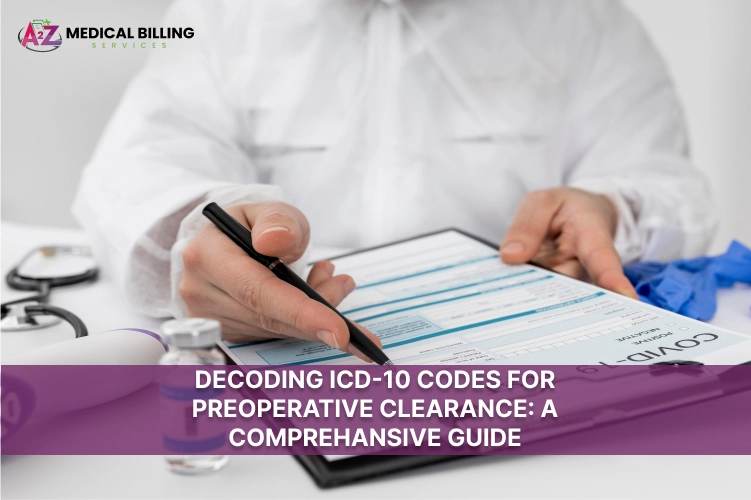When it comes to medical operations, it is crucial to make sure patients are safe and healthy before surgery. Preoperative clearance, sometimes documented using specific ICD-10 codes, plays a significant role in this procedure. We will explore the particulars of ICD-10 codes of preoperative clearance in this extensive guide, providing insight into their importance and application in the healthcare system.
Preoperative clearance is an important part of the holistic care of patients undergoing surgical procedures in the field of medical coding, particularly under the International Classification of Diseases, 10th Edition (ICD-10). To facilitate correct documentation and payment in the healthcare system, ICD-10 acts as the standardized coding system for diseases, disorders, and other health-related issues.
Before a patient undergoes surgery, a comprehensive evaluation of their health status is known as preoperative clearance. By considering the patient’s overall health, medical history, and current problems, this method seeks to guarantee that they are medically fit for the next surgery. When it comes to recording and expressing these facets of a patient’s health, ICD-10 codes are essential.
ICD-10 codes are used by healthcare providers to identify and group different illnesses and ailments. They offer a common language that makes it easy for medical staff, insurance companies, and administrative staff to communicate with one another. These codes aid in identifying the precise medical conditions that could influence the surgical decision-making process when it comes to preoperative clearance.
Understanding ICD-10 Codes for Preoperative Clearance:
Basics of ICD-10 Codes:
Let’s establish the groundwork for an understanding of ICD-10 codes before we delve into the precise codes for preoperative clearance. A global system for medical classification is the International Classification of Diseases, Tenth Edition (ICD-10). It offers a uniform method for recording different medical treatments and conditions.
Preoperative clearance is important since it entails a comprehensive evaluation of a patient’s health before surgery. This assessment reduces the risks related to surgery and guarantees that the patient is in the best possible condition for the scheduled procedure. It is crucial to comprehend the particular ICD-10 codes linked to preoperative clearance to ensure precise documentation and efficient healthcare procedures.
ICD-10 codes that are frequently used for preoperative clearance
Let’s explore a few of the most important ICD-10 codes for preoperative clearance:
Z01.818 is the ICD-10 code for preoperative clearance
Z01.818 is a unique number in the 10th edition of the International Classification of Diseases (ICD-10) that is used to identify cases of preoperative clearance.
Definition and Purpose:
Preoperative Clearance
This code is assigned when a patient undergoes a comprehensive evaluation before a planned surgical procedure to assess their overall health status and identify any potential risks or issues that might affect the surgery.
Criteria for Inclusion:
Comprehensive Health Assessment
Z01.818 is utilized when medical professionals perform a comprehensive assessment, including the patient’s past medical history, present health issues, and any other pertinent information that could affect the surgical result.
Risk Factor Documentation:
Chronic Conditions
When, during the preoperative evaluation, chronic problems like diabetes, heart disease, respiratory difficulties, or other health issues are discovered, the code is applicable. These variables may have a big impact on the patient’s per-operative care.
Communication Across Disciplines:
Coordinated Care Z01.818 fosters effective communication among healthcare providers involved in the patient’s care. This code allows for the standardization and easy sharing of pertinent patient health information among various specializations, guaranteeing comprehensive and well-coordinated care.
Administrative and billing purposes:
Accurate Compensation
Using Z01.818 correctly in medical records is crucial to precise invoicing and payment procedures. This number facilitates the administrative process by making it evident that the medical services rendered are related to preoperative clearance.
ICD-10 Surgical Clearance:
ICD-10 Preoperative Evaluation:
ICD-10 Preop Testing:
ICD-10 for Surgery Medical Clearance:
Decoding Specific ICD-10 Codes:
Specific details regarding the patient’s condition or the clearance’s intended use are contained in each code. We’ll interpret these codes and talk about how they can be used in various situations.
Preoperative clearance billing is a crucial part of managing hospital resources; correct payment and long-term financial viability depend on strict adherence to billing policies. This is a thorough guide on preoperative clearance billing that addresses important factors, coding conventions, and compliance procedures:
ICD-10 Preoperative Clearance Types and Their Remedies:
1. Chronic Pre-existing Diseases (ICD-10 Code Z01.818):
Managing chronic illnesses with customized programs guarantees the best control before surgery. Working together, several physicians can stabilize the patient’s condition and reduce the danger of surgery.
2. Heart-related Problems (ICD-10 Codes: I25.10 for Atherosclerotic Heart Disease):
Thorough cardiovascular evaluations, such as echocardiograms and stress tests, aid in the identification and management of heart-related concerns. A coordinated approach is ensured by cardiologists and surgeons working together.
3. Respiratory disorders (such as J45.909 for Unspecified Asthma in the ICD-10):
Respiratory conditions are managed with the aid of preoperative respiratory examinations, such as spirometry and chest X-rays. Working together with pulmonologists guarantees that lung function is optimized before surgery.
4. Diabetes (Type 2 Diabetes Mellitus, ICD-10 Code E11.9):
Diabetes can be managed before surgery, which lowers the risk of per operative complications, by stabilizing blood glucose levels by medication changes, lifestyle changes, and cooperation with endocrinologists.
5 Concerns About Medication (ICD-10 Code Z79.899 for Extended Current Drug Therapy):
The risk of adverse reactions before and after surgery can be reduced by reviewing existing medications, addressing potential interactions, and changing drug regimens as necessary.
6. Infectious Conditions (Carrier of Infectious Disease, ICD-10 Code Z22.9):
The risk of surgical site infections can be reduced by identifying infectious disease carriers and putting in place the necessary control measures, such as isolation protocols or preoperative antibiotics.
7. Age-Related Concerns (Routine Child Health Examination Encounter, ICD-10 Code Z00.121):
A thorough geriatric assessment takes cognitive ability, functional status, and age-related issues into account for senior patients. This makes it easier to customize preoperative treatment to meet unique requirements and worries.
8. Psychosocial Factors (Z71.89 in ICD-10 for Other Counselling):
Pre-operative patient well-being is enhanced by recognizing and treating psychosocial issues, such as depression or anxiety, through mental health professional collaboration or therapy.
Billing for preoperative clearance is a critical aspect of healthcare administration, requiring careful adherence to billing guidelines to ensure accurate reimbursement and financial sustainability. Here’s a comprehensive guide on billing for preoperative clearance, covering key considerations, coding practices, and compliance measures:
Recognize Payer Policies:
Whether it’s a private insurance company, Medicare, or Medicaid, familiarize yourself with the particular policies of the payer concerned. Requirements for preoperative clearance billing may differ amongst payers.
Verify Patient Eligibility and Coverage:
Check the patient’s eligibility and coverage information with the insurance company prior to starting the preoperative clearance procedure. This guarantees that the patient’s plan pays for the required assessments and helps avoid any billing problems.
Use the Correct ICD-10 Codes:
Successful billing depends on accurate coding. Make use of the appropriate ICD-10 codes that most accurately reflect the patient’s state, the reason for the preoperative clearance, and any underlying medical conditions that might affect the procedure.
Incorporate Required CPT Codes:
The services or operations carried out are indicated by Current Procedural Terminology (CPT) codes. Make sure you provide the correct CPT codes for the consultations, preoperative evaluations, and any extra services rendered throughout the clearance procedure.
Document Medical Necessity:
Make sure the patient’s medical records expressly state that the preoperative clearance is medically necessary. This paperwork is essential for responding to any payer inquiries or audits since it bolsters the explanation for the services provided.
Billing for Consultations vs. Evaluations:
Recognize the differences in billing procedures between consultations and evaluations. Evaluations concentrate on determining if the patient is surgically fit, whereas consultations entail consulting with another medical professional. Represent these differences in your billing procedures accurately.
Time-Based Billing Considerations:
Be mindful of time-based billing codes if the preoperative clearance requires lengthy evaluations or consultations. Careful recording of the time spent on each component is crucial because some services might be billed according to the amount of time spent with the patient.
Use of Modifiers:
When required, apply the proper modifiers. Additional details about the service are supplied by modifiers. Modifiers could say, for instance, whether a service was rendered in a facility or outside of one, or whether more than one treatment was carried out.
Coordination of Benefits (COB):
Make sure that the patient’s benefits are properly coordinated if they have various insurance policies. To avoid billing problems and delays, clearly identify the primary and secondary insurers and adhere to the coordination rules.
Adherence to the National Correct Coding Initiative (NCCI) Editing Guidelines:
In certain situations, the NCCI modifies outline code pairings that shouldn’t be billed together. Examine these changes to make sure they comply and avoid rejections. Stay up to date on any changes by checking for updates on a regular basis.
File Clean Claims:
Filing clean claims lessens the possibility that they will be denied. Make sure you accurately fill out all the essential fields and attach any applicable supporting documentation. The submission of accurate and timely claims improves the reimbursement process.
Keep Up With Billing Regulations:
Stay up to date on any modifications to the rules governing billing and coding. To stay up to date with the most recent regulations, regularly study updates from pertinent organizations, payer bulletins, and regulatory agencies.
Employ Systems for Electronic Health Records (EHRs):
The billing procedure is streamlined by electronic health records. To reduce the possibility of errors associated with manual record-keeping, manage billing data effectively, and capture preoperative clearance information, make use of EHR technologies.
Train Employees on Billing Processes:
Make certain that the members of your healthcare team, particularly the coding and billing specialists, have received the most recent training on billing practices and policies. Frequent training sessions can support compliance maintenance and error prevention.
Auditing and Monitoring:
To ensure that billing procedures are accurate, conduct routine internal audits. To avoid any possible compliance problems and to maximize the revenue cycle, quickly identify and resolve any differences.
Scenario: Billing for Preoperative Clearance Exam
Patient Information:
Patient Name: John Doe
Date of Birth: January 15, 1975
Insurance Provider: XYZ Health Insurance
Scenario Description:
John Doe is scheduled for elective surgery, and his surgeon has requested a preoperative clearance exam to assess his overall health status and identify any potential risks related to the upcoming procedure.
Steps for Billing:
Insurance Verification:
Confirm John Doe’s eligibility and coverage under XYZ Health Insurance. Verify that the preoperative clearance exam is a covered service under his insurance plan.
Scheduling and Documentation:
Schedule the preoperative clearance exam and ensure that the appointment includes a comprehensive evaluation of John Doe’s health. Document all relevant information, including medical history, vital signs, and any additional assessments conducted during the clearance exam.
ICD-10 Code Selection:
Choose appropriate ICD-10 codes based on John Doe’s health conditions and the purpose of the preoperative clearance. For example:
ICD-10 Code for Routine General Medical Examination: Z00.00
ICD-10 Code for Encounter for Preprocedural Laboratory Examination: Z01.81
CPT Code Selection:
Select relevant Current Procedural Terminology (CPT) codes based on the services provided during the preoperative clearance exam. Examples include:
CPT Code for Comprehensive preventive medicine evaluation and management: 99387
CPT Code for Preoperative assessment including history and physical: 99204
Modifier Usage:
Apply appropriate modifiers if required. For instance, if the preoperative clearance involves extensive time spent with the patient, consider using the time-based modifier, such as modifier 22.
Coordination of Benefits (COB):
If John Doe has secondary insurance coverage, coordinate benefits by indicating the primary and secondary insurers. Follow the COB guidelines to ensure accurate billing.
Documentation of Medical Necessity:
Clearly document the medical necessity of the preoperative clearance exam in John Doe’s medical records. Include details about the surgery, the surgeon’s request, and any health conditions that may impact the procedure.
Electronic Health Records (EHR) Documentation:
Utilize the electronic health records (EHR) system to input all relevant information and ensure accurate and efficient documentation of the preoperative clearance exam
Clean Claims Submission:
Compile all necessary information and submit a clean claim to XYZ Health Insurance. Ensure that all fields are completed accurately, and attach any required supporting documentation, such as medical records and test results.
Follow-Up and Reconciliation:
Monitor the status of the claim submitted for the preoperative clearance exam. Follow up with the insurance provider if there are any delays or denials. Reconcile any discrepancies and address any additional documentation requests promptly.
Auditing for Compliance:
Conduct internal audits to ensure compliance with coding guidelines and billing regulations. Identify any areas of improvement and implement corrective measures as needed.
Patient Education on Billing:
Communicate with John Doe about the billing process, including potential out-of-pocket costs, co-payments, and any deductible obligations. Provide clarity on the insurance coverage for the preoperative clearance exam.
Coding Review and Updates:
Regularly review coding guidelines and updates to stay informed about any changes in coding practices. Implement changes in coding procedures as needed to remain compliant with industry standards.
By following these steps, healthcare providers can navigate the billing process for preoperative clearance exams effectively, ensuring accurate reimbursement and contributing to the seamless delivery of patient care.
Final Thoughts:
We have negotiated the complex landscape of ICD-10 codes for preoperative clearance in this extensive tutorial. Knowing these codes is critical for correct paperwork, but it’s also critical for guaranteeing the safety and well-being of patients having surgery. Healthcare workers across specialities will find it more and more crucial to remain knowledgeable about the subtleties of preoperative clearance coding as healthcare advances.
A multidisciplinary strategy is necessary to address different kinds of preoperative clearance concerns, with an emphasis on collaboration between diverse medical disciplines. Customized remedies for particular problems enhance a thorough and patient-focused preoperative care plan, which in turn enhances surgical results.



